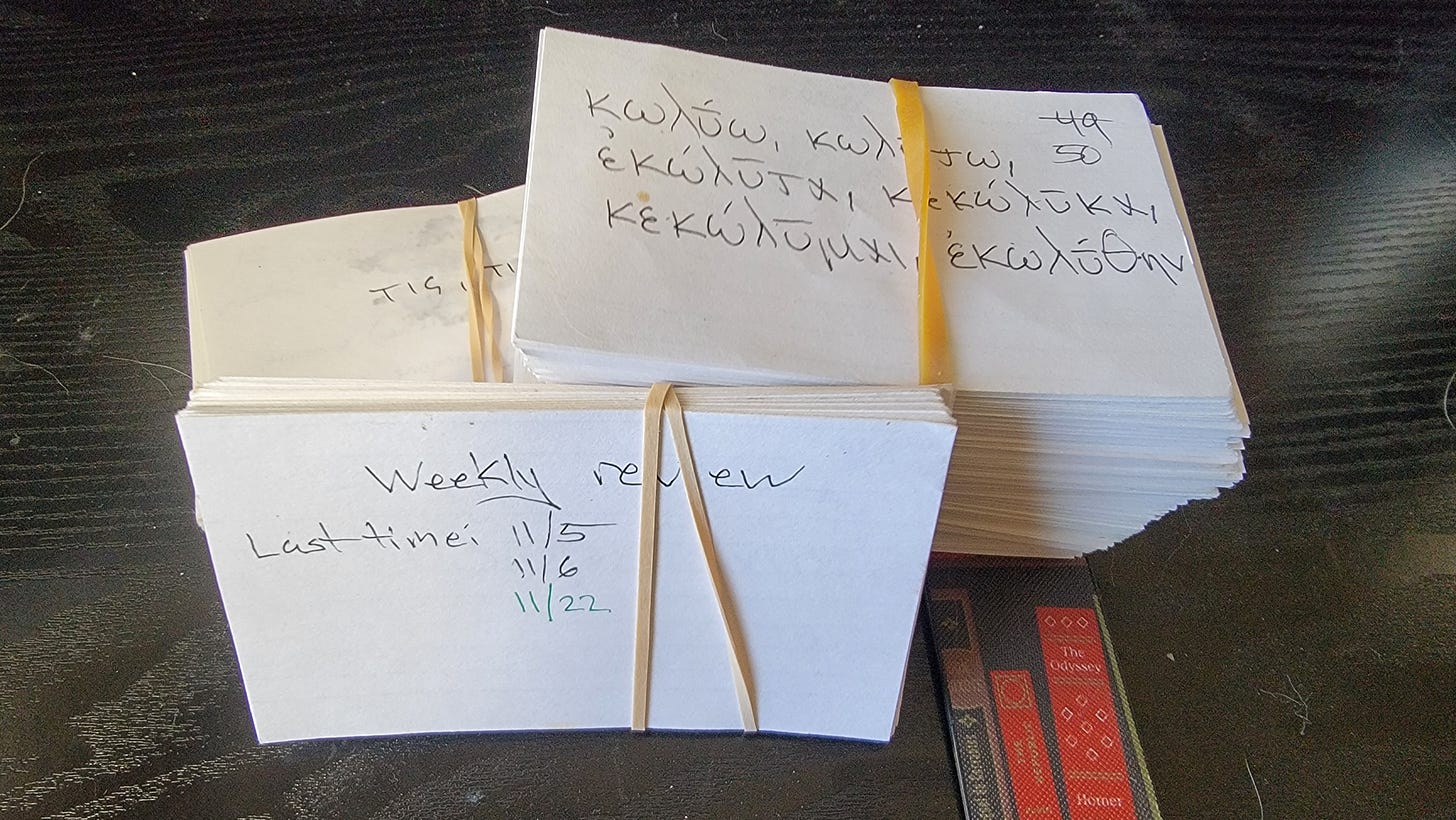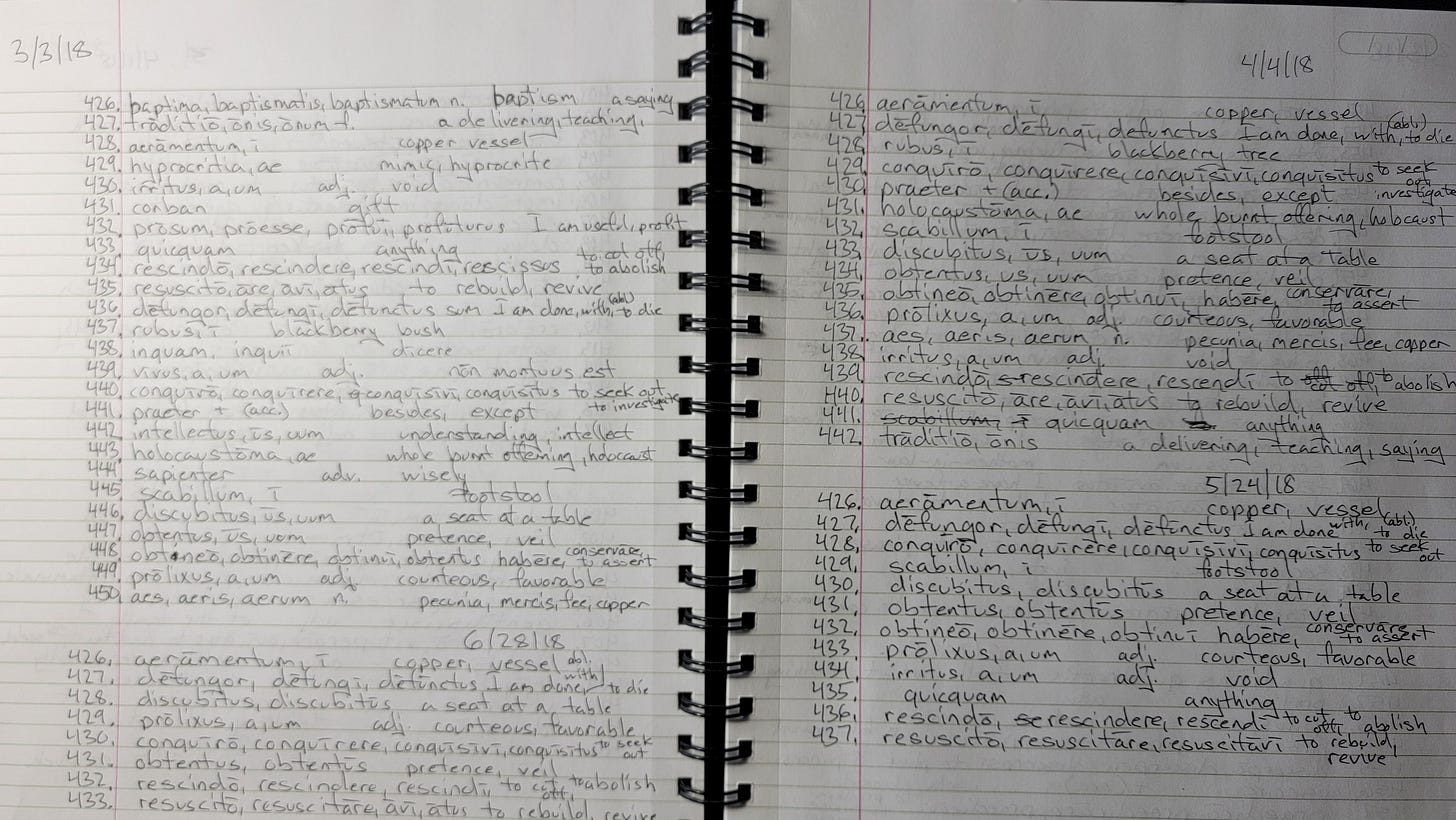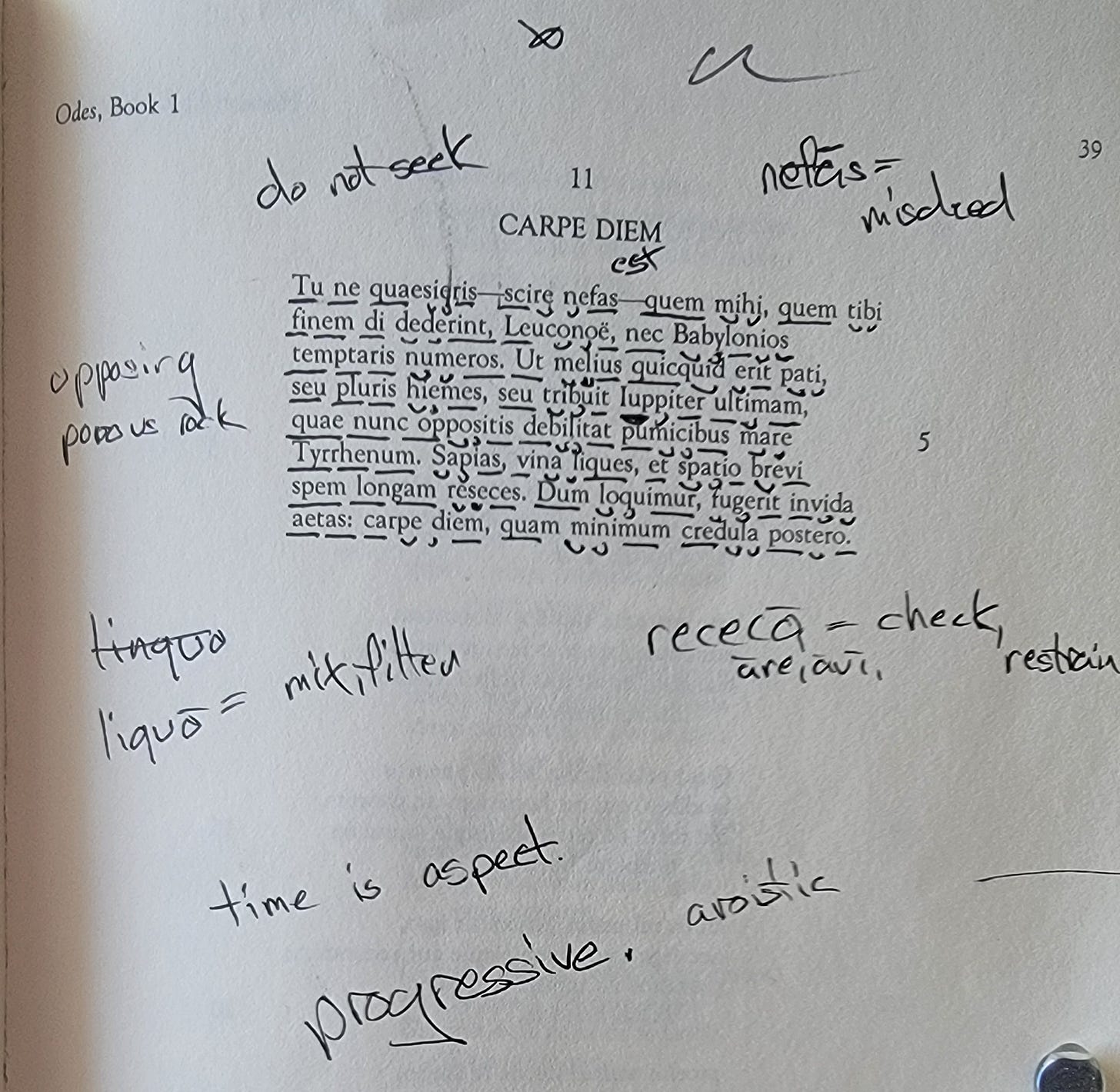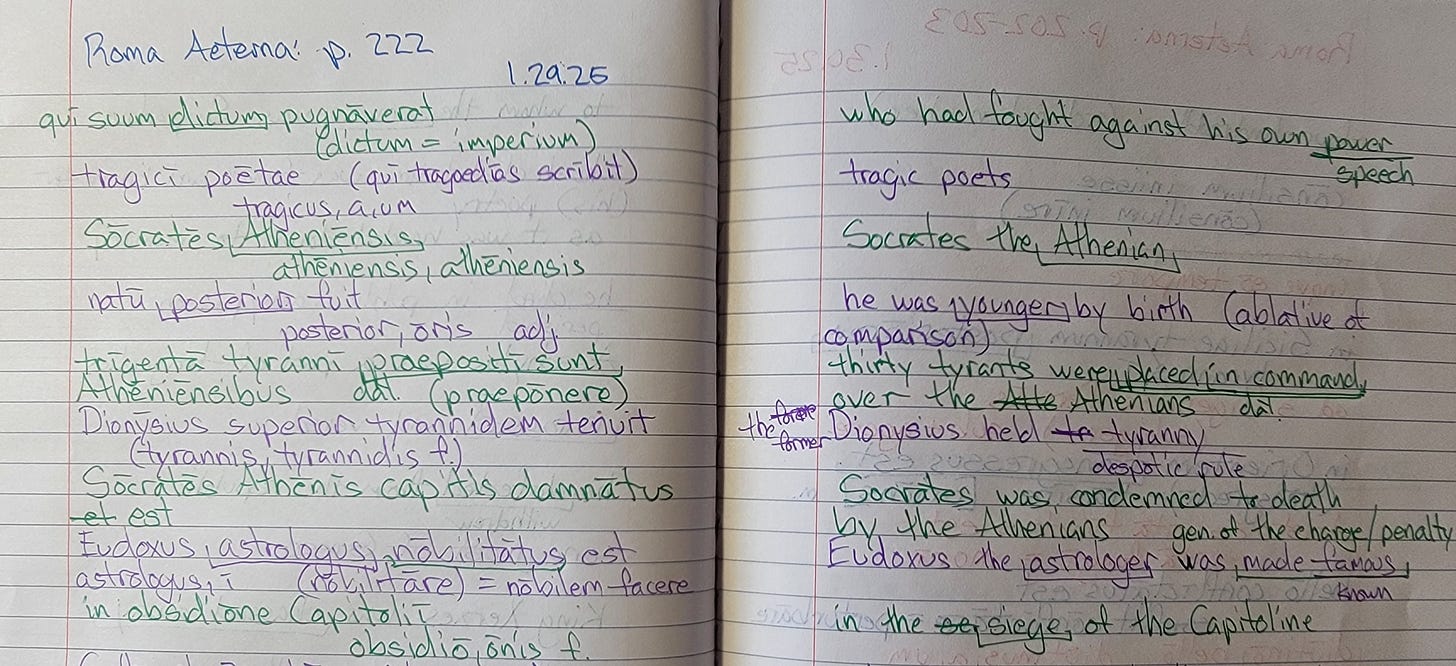This week’s article will be a short history of some of the methods I’ve used over the last thirteen years to learn Latin, and more importantly, to learn its vocabulary. If I’ve learned anything over these years teaching myself a language, it’s that learning vocabulary and finding a method that works for you, might be the single most important aspect of your language learning journey, with everything else falling to the wayside. Period. What is more, learning grammar is not even a close second in importance compared to learning vocabulary. Yes, not even studying the grammar of Latin is as important as figuring out a method of learning its vocabulary.
If only I knew this truth when I first set out to learn.
No matter how much grammar one knows, it matters not at all if they are staring at a page of Cicero while ignorant of half its words! Grammar will only help you get so far, because, if you’re stumbling right out of the gate with the first word and its meaning, how will you possibly be able to come to grips with the meaning of the page before you?
My First Foray Into Latin (2012): Part One
When I first started to teach myself Latin in 2012, let’s just say I had zero idea of what I was doing, see my article, We Are What We Read. Not only did I have no clue how to study a language, I had no clue how to study in general. At that time, I couldn’t take notes to save my life; however, I had a zeal to learn and wanted to be educated, which is half the battle in learning anything. After I bought my first Latin book and started to read, I don’t remember taking notes, but just jotting down the declensions and conjugations in my notebook. However, when I ventured out to read my second Latin book (I didn’t finish my first one) I started to make flashcards. It goes without saying I had no idea what to do with flashcards, besides just making them and “hoping” for the best. At this time, I also remember thinking, how the hell can one language have so many words to learn!
If only I knew!
The book I was using was Ecce Romani (not a terrible book by the way), and I would make cards for every new chapter. None of this was very organized, but I did make progress along the way. Thus, my first foray into flashcards and Latin vocabulary was a hit or miss. Although I did learn new words (I couldn’t possibly tell you how many), I had no system in place, and no way to discard memorized cards. Hence, I always felt frustrated that I hadn’t “mastered” anything, much less the ability to even read the “fake Latin” in the textbook fluently. Thus, I had much more to learn and was what the Romans called, a tiro (a novice, a fresh recruit).
Part Two
Several years later while managing a coffee shop, I started to get back into Latin again and I wanted to find new and better ways to learn vocabulary. At this time I was learning all the vocab from the Gospel of Mark — which was an interesting choice now that I think about it — and I wanted to see what method would work best. Thus, I tried three methods while simultaneously going about this enterprise of learning vocabulary. One of them was an utter disaster and didn’t work out at all. The second one was successful to an extent, but was wrought with long-term difficulties that I could never remedy. I even tried the second method again recently with the same results. The third method, although it was the best of the three, failed in some respects to my newest and favorite method, which I’ll get to later.
The First Method: The GoldList Method
When I first read about this method, it seemed so promising that I dove in headfirst to taste of its delights; however, what I found did not work in the end. It is somewhat like a space-repetition method, where you wait a few days (or weeks) before you look at a word again, so that, when you review it, you’re on the threshold of forgetting, which is good for long-term memory recall. This seemed great because I had just read about the Anki space-repetition flashcard app (see below) which did the same thing, so I was excited to see how this magic would play out in the analog world of notebooks.
The method goes something like this. You get yourself three notebooks and name them formally as follows: the gold, the silver, and the bronze notebook. Now you find your list of words you want to learn, and then write them down nice and beautifully in the first book, the gold notebook. The slower and more mindfully you write the better. Then you wait two weeks before retuning to it again, to see what words you can recall, and which ones you cannot. If you cannot remember them, you write them on the other side of the page and you wait for another two weeks. During this time, however, you’re filling the the gold book with more and more new words. Eventually, after you’ve filled a page worth of distilled lists in your original gold book, you add a silver book to the mix, and then after that the the bronze book. Of course theoretically, every time you move words around, either from page to page or from book to book, you’re distilling them and the list is getting shorter and smaller, or at least hopefully.
Pros
I did like Goldlist Method’s pedagogical outlook, especially in not trying to “memorize” anything but only casually writing words down and returning to them later. Forced memorization is stored in your short-term memory only, so this is something to keep in mind when setting out to learn vocabulary. Trying hard, studying hard, cramming till midnight, these are NOT the best methods for long term success; however, I will say they are useful in certain situations. Another aspect I liked with this method was writing everything out by hand, something that I’ve grown to love over the years, and is a huge part of my new method.
Cons
No matter some of its strengths, this method simply didn’t work for me in the end. I grew terribly bored with it and never reached a point where I felt I was learning and retaining words. Even though I distilled the lists and they grew smaller, I often felt I was just shrinking it because I “needed” to and not because I had mastered the words yet. Furthermore, and most importantly, there was no context to these word lists, and context is everything in language learning. Although they were sourced from the Gospel of Mark, which gave me context when I read it, the lists in the notebooks themselves were just random words to memorize, which became quite tiresome to me and not very helpful.
Second Method: The Anki App
As I mentioned above, this is a space-repetition app you can download for free on you computer or phone. Space-repetition is Anki’s best feature. Also, unlike my previous flashcard experience, Anki automatically organizes your cards for you, so if you alreadly know a card in your deck, you can just a push the “easy” button and Anki won’t show you that card again for sometime. Another feature of Anki is that you can either download premade flashcards from Anki users, or create your own. This is helpful in finetuning your particular needs.
Pros
As someone who is not naturally organized, Anki is easy to keep yourself on the straight and narrow and focused on what you need to see each and everyday. With Anki, you don’t have to worry about seeing one card over and over again that you alreadly know. Sure, you can get more sophisticated in organizing handmade flashcards (I have learned to do that recently), however, the relative ease of Anki doing it for you is hard to argue with. Many language learners swear by this method and it has been a great success for them. I can clearly see Anki’s strengths, and I’m happy for anyone who has found success using it, however, I do have my complaints.
Cons
On the long term, I get bored using Anki. It’s as simple as that. I have tried probably three times altogether over the years, however, each and every time I grew tired of using it within a month or so. As I’ve alreadly said before, and it bares repeating here again, no matter how “good” a method is (even if everyone else loves it), if it doesn’t work for YOU then it’s not a good method. If a method is “great” but you can’t stick with it for the long term, then how is it going to benefit you? Anki is great for short term marathons of language learning, say, learning the first 500 words or so of a new language. Those first 500 words need to be learned as quickly and efficiently as possible, and in that sense, Anki is perfect. But beyond that, it just bores me to no end.
Another problem I’ve found with Anki, is that you have to do it everyday or else, your review cards start piling up and this becomes a chore in and of itself. This creates stress, and makes me loathe the language learning process, which is not good in the long term. The last time I tried Anki five months ago, I never missed a day for a whole month, however, I started to grow weary because I knew if I stopped, the review cards would start piling up and become a chore. I “dutifully” pressed on. Eventually, I called it quits; I decided I wasn’t going to stick with a method just because many others liked it. Although I did learn a good bit that month using Anki — which was nice — I became bored of the process, bored of using flashcards, and especially bored doing it on the computer. If I’ve learned anything, writing by hand is where it’s at.
Third Method: The Folded Paper Method
This method is my favorite, besides what I just started four months ago, and it’s so simple in fact, it’s almost comical. Just fold a paper in half, side to side, and write the words you’re learning on the left side and their English equivalents on the right. Then fold the paper to cover the English, and look at the first word on the left trying to recall what its English equivalent is. If you get it right, perfect, if not, try again, and work your way down the page with each new word until you’ve mastered the words. That is the method. Although it’s not perfect, I managed to learn the vocabulary from the Gospel of Mark relatively easy, so that’s saying something. I remember walking for hours in the park with my paper in hand, learning vocabulary and getting some sun and exercise at the same time. Just watch out for running into strangers or tripping on rocks!
Pros
What I liked about this method is that I made the list by hand, unlike using Anki. What is more, unlike the Goldlist Method, I could get a list of words and “work” them for hours at a time, and it wasn’t so casual as writing them down and not be seen again for two weeks. Don’t get me wrong, rote memorization is necessary for any language learning, so that wasn’t my problem with Anki; boredom was the problem. This method demands “work” and memorization, but it’s fun and you can do it anywhere and not have to be on your phone; these are all bonuses.
Cons
The only real downside with this method is you will see certain words that you know over and over again, just like my unorganized flashcards. This is not great but it’s not bad either, because you will definitely never forget them. Furthermore, you can always just skip over the words you know, or get a fresh piece of paper and start another list with the words you still don’t know, and add new ones to the mix. Needless to say, this method was the best out of the three.
Part Three
My New Favorite Method
Before I get to my favorite method, I will quickly describe what I did for vocabulary learning when I went back to school to study Latin three years ago. With every reading assignment I had, I would first read and figure out all the words I didn’t know. Then I would look up each word and write the definition in my textbook in the margins right beside the underlined Latin word I didn’t know. Then I would read the passage over and over again until I could “mostly” read it smoothly. What I liked about this method was I was learning new words in the context of where I found them, which is extremely important for language acquisition. Learning lists of words without context for the most part is a waste of time, and by doing this, I learned a great truth, which is something I would incorporate into my newest method.
My New Method
After graduation I was still unsatisfied about my vocabulary methods, and I felt the need to search for something I could actually stick with and get the results I wanted. Although the folded paper method is great in most respects, it would leave me with piles of folded papers lying about never to be organized. Furthermore, while the method I used in school was nice and generally worked, I like rote memorization, and although it worked to get me through school, I wanted a method that would utilize everything that I’ve learned so far over the years.
Luca Lampariello’ Method
On YouTube you can find a language polyglot named Luca Lampariello. Lampariello is an extremely talented language learner, who I believe knows something like twelve languages now — crazy! I would definitely check him out if you have not. Anyway, as I was ending my month of Anki torture — for I had promised myself I had to stick with it for at least a month — I was looking for another method and came upon Lampariello. Here at last I found a method that might actually work for me!
The method goes like this. First you get a nice notebook and pen, and then you find some reading material or transcribed media that you like. Next, you underline any chucks of language (language phrases) that you don’t know into the notebook on the left side. Then, you write the translation of that chuck of language on the right side of the notebook, you can also use a translation that’s not your own. You do this until you fill up the whole page. All of these chucks of language will have a word that you don’t know, BUT within the context of where they were in the sentence. Then for review, you can look at it whenever you want to. Lamariello suggested writing a page everyday and reviewing on the weekends. That is the method.
This method is so simple it’s almost ridiculous when you think about it; however, it incorporates everything that I loved about each of the others into one streamlined process.
Like the Goldlists Method, I get to write by hand which helps me learn better than writing on the computer. Furthermore, when reviewing, I can either be “casual” and flip through it, or I can “work” it and translate each English phrase back into Latin, either orally or in writing, thus it gives me flexibility and freedom, my highest learning value. Further, unlike Anki, I can review it whenever I want to. If I’m too busy on the weekends or just don’t feel like it, I don’t have to stress about a thirty minute review session on Monday because I was a “bad boy.” Plus, since all the words are in their original context, I can learn and recall them faster than if they were just a list of words.
I have learned more Latin these last four months with this system than anytime before, and by that I mean learning new words. What’s great is that it’s both organized AND it’s all in one notebook, thus, I can bring it wherever I go and study it whenever. Furthermore, since it’s actually working for me, I’ve been reviewing it more and more, because, when you find something that actually works, you tend to do it more and more; something I could never say about the other methods. What’s convenient too, is that I write the title of the book I’m sourcing the words from on top of the page, in this case, Roma Aeterna, along with the page number and date. Doing this, I can easily review it along with rereading a certain passage in the book, and it’s all very organized.
Thank you for reading this very long essay on my journey of finding a method that works for me. Although this method works for me, it might not work for you, but you won’t know until you try. I would suggest trying many methods (including others not mentioned) and seeing which ones work best. There’s no such thing is “one best method,” we all learn differently, so it only makes sense that we would be drawn to certain methods over another.
What are your methods of learning vocabulary? I would love to hear.
Thanks for reading, dear readers.
Please share if you found this helpful.









If only this method worked for Japanese. Kanji are just too complicated to write. And writing is such an important part of learning. So, for now, I try to do my Anki deck each day, study my grammar book which uses manga to keep it interesting, and try to transcribe one or two sentences from a Japanese book. Slow progress but more than I knew the day before.
Thanks for sharing this, I've hit every single one of these roadblocks with Latin. So, happy to see a method that looks like it might work!